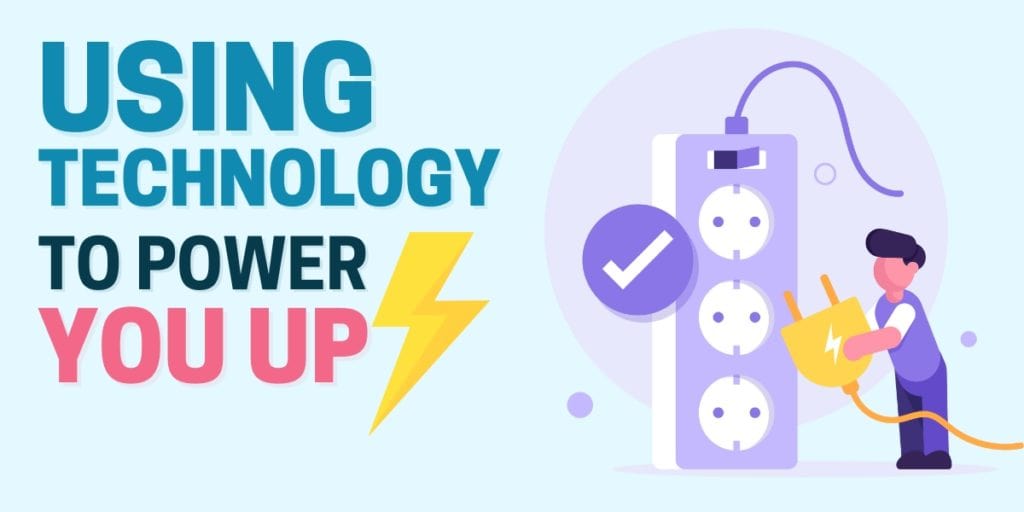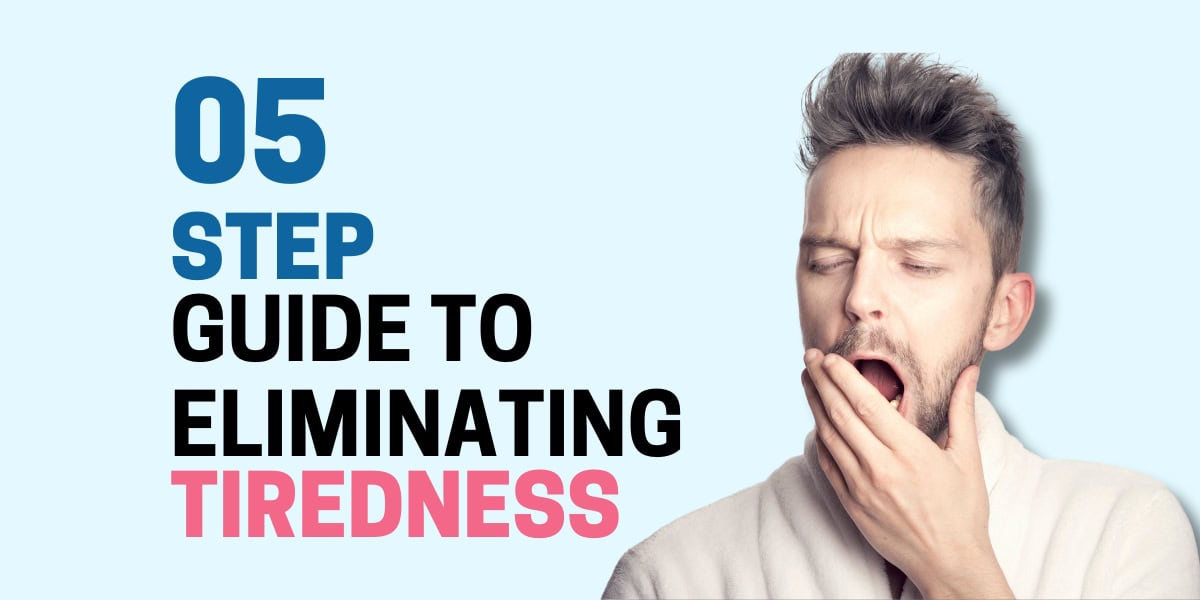5-Step Guide to Eliminating Tiredness All the Time
Do you feel a sense of tiredness all the time? Ever been so tired that you tried toasting a napkin thinking it was bread? …Ahem (neither have I—just asking for a friend).
Don’t be ashamed if you constantly feel worn out—you’re not alone. A lot of people go through the same thing, and it can seriously mess with their productivity and well-being.
The standard advice of “just sleep more” often fails to solve this common problem. Instead, people are left wondering if they can do more to maintain and improve their energy levels.
And you know what? There is.
Consider a different approach.
The real game-changer is understanding that several factors contribute to low energy, not just poor sleep. The usual advice given, often fails because they address the symptoms rather than the underlying problem.
Let’s examine how different aspects of your lifestyle affect your energy levels and come up with solutions to fix the underlying issues.
So, let’s get started.
Introducing “The 5-Step Guide to Fighting Fatigue and Reclaiming Your Vitality,” a structured process designed to help you understand the root causes of your daily fatigue and implement practical solutions for a more energetic and fulfilling life.
This guide will walk you through various actionable steps, from tweaking your diet to leveraging cutting-edge technology, ensuring a complete approach to boosting your energy levels.
Steps to Revitalise Your Energy and Stop Your Tiredness All the Time:
- Energy Audit: Identifying the Causes of Persistent Fatigue
- Dietary Tune-Up: Optimising Your Diet for Improved Energy
- Supplemental Support: Selecting the Right Energy Boosters
- Health Alerts: Detecting Health Risks from Ongoing Chronic Fatigue Syndrome
- Tech Boost: Utilising Technology to Boost and Manage Energy Levels
Each step is a building block in your expedition toward a life brimming with energy.
Whether you’re adjusting your diet or optimising your sleep environment, these steps are tailored to help you identify and fix the issues contributing to your tiredness.
Ready to dive deeper?
Let’s explore each step in detail and discover how you can start feeling more vibrant and energetic starting today.

Step One: Identifying the Causes of Persistent Fatigue
Like a phone battery, our bodies also need recharging; unfortunately, life doesn’t come with a power adapter. So, if you’re experiencing tiredness all the time, it’s crucial to first recognise the root causes.
We’ll begin by determining whether lifestyle choices, medical conditions, or psychological factors are causing your tiredness.
Examples could be:
Poor Nutrition: If your diet lacks essential nutrients or you often skip meals, your body won’t receive the necessary fuel to function optimally—leaving you feeling sluggish and tired.
Identifying a lousy diet can assist you in your decision-making to switch to better eating habits. Hopefully, it’s something you realise sooner rather than later.
So, including more foods rich in vitamins and minerals is ideal for your body’s energy production.
Add foods such as leafy greens, whole grains, lean proteins, fatty fish, berries, sweet potatoes, yogurt, nuts, and seeds to your diet.
Lack of Quality Sleep: As obvious as it seems, poor sleep quality can affect your energy levels significantly, leading to insomnia, frequent awakenings, or other sleeping disorders.
It’s not just about the number of hours you sleep but also the quality of sleep you get. If you don’t look after yourself, you can end up way too exhausted—bad enough to fall asleep in the middle of a hurricane (if that was a thing).
To improve your sleep quality, you may need to make some lifestyle changes. Adjust your environment or seek medical advice, especially if you have a sleep disorder.
Check out my post on how I dealt with my sleep apnea, which kept me from having quality sleep.
Chronic Stress: Constant stress can greatly impact and drain your energy. When stressed, your body is constantly on alert, which can be incredibly taxing. It’ll eventually eat up all your energy reserves.
If you’re lucky, you won’t need coffee anymore. Your body will be powered by pure panic instead. Okay, I’m kidding. No one wants that!
Physical Inactivity: Surprisingly, an inactive lifestyle can also lead to low energy levels. Many of us have jobs requiring sitting at our desk for hours on end. And when combined with a passive lifestyle outside of work, it can hurt our energy levels.
However, regular physical activity can help counteract this issue by boosting energy levels and improving overall health.
When we exercise regularly, our body converts food into energy more efficiently. This process is known as metabolism. Increasing our metabolic rate can produce and utilise energy more effectively.
As a result, we feel less tired and more active throughout the day, which can lead to a healthier and more energetic lifestyle.
Underlying Health Conditions: Fatigue is a common problem that most people experience at some point. While often it’s caused by lack of energy, stress, or overexertion, sometimes it can be a symptom of an underlying health condition.
Medical conditions such as anaemia, thyroid problems, diabetes, heart disease, or chronic infections can all cause significant tiredness.
Anaemia occurs when the body doesn’t have enough red blood cells to carry oxygen to tissues and organs. This condition can result in extreme fatigue, weakness, and shortness of breath.
Similarly, thyroid problems such as hypothyroidism (where the thyroid is underactive) or hyperthyroidism (where the thyroid is overactive) can cause fatigue, weight gain, weight loss, mood swings, and changes in energy levels.
High blood sugar levels, which are commonly seen in diabetes, can also make you feel tired and sluggish.
Heart disease can cause fatigue if left untreated, and chronic infections such as HIV or hepatitis, as well as autoimmune disorders such as lupus or rheumatoid arthritis, can also result in fatigue.
If you are experiencing persistent fatigue, it is important to talk to your doctor. Identifying that your low energy might be due to a health condition is critical for seeking appropriate medical evaluation and treatment. Your doctor can help you determine the underlying cause of your fatigue and provide you with a treatment plan to help you feel better.
Step 2: Optimising Your Diet for Improved Energy
The food you consume plays a crucial role in determining your energy levels throughout the day. Eating a well-balanced diet rich in vegetables, proteins, and complex carbohydrates helps fuel your body continuously to maintain a steady energy supply.
It’s also a mood enhancer, helping to lift your spirits sky-high.
It’s important not to skip this step, as it is just as essential as other steps in maintaining good health.
Examples of balanced meals that can provide you with a steady supply of energy throughout the day include:
1. Breakfast:
- Oatmeal with mixed berries and nuts
- Whole-grain toast with avocado and scrambled eggs
- Greek yogurt with granola and fruit
2. Lunch:
- Grilled chicken or tofu with mixed vegetables and brown rice
- A salad with mixed greens, grilled chicken or fish, and a variety of vegetables
- Lentil soup with a whole-grain roll
3. Dinner:
- Baked salmon with roasted sweet potatoes and broccoli
- Stir-fry with mixed vegetables, tofu or lean protein, and brown rice
- Whole-wheat pasta with marinara sauce, grilled chicken or shrimp, and mixed vegetables
These meals are nutrient-rich and provide a balanced combination of carbohydrates, proteins, and healthy fats. They are also low in processed foods and added sugars, which can cause energy crashes.
By including these meals in your diet and eating at regular intervals, you can maintain a consistent energy supply throughout the day, preventing mid-day slumps.
A bonus snack I would suggest is the dried apricot.
The dried apricot contains natural sugars like fructose and glucose, providing a quick, natural energy boost without the crash associated with refined sugars.
Despite their sweetness, dried apricots have a low glycemic index (GI), meaning they provide a slow and steady release of energy into your bloodstream.
When dried, apricots retain small amounts of water and are high in soluble fibres, which can help maintain fluid balance in your body, keeping you hydrated and energetic.
The best part is that they’re easy to pack and carry.
Dried apricots make a convenient snack for an on-the-go energy boost—whether you’re hiking, working, or just running errands.

Step 3: Selecting the Right Energy Boosters
After these foundational lifestyle changes, supplements can also enhance your energy further.
Supplements should complement, not replace, healthy habits.
One good supplement is Vitamin D.
Research has shown that low levels of vitamin D have been linked to fatigue and mood disorders. This vitamin is essential for bone health and immune function, and it can also help improve energy levels, especially for those who don’t get enough sun exposure.
Another supplement to try is antioxidants.
They fight the bad guys in your body, which are the pesky villains that make you age faster and can damage your cells.
Antioxidants are found in lots of fruits and veggies, like blueberries, strawberries, and spinach. You can also find them in dark chocolate and pecans—yum!
Some studies suggest that antioxidants can reduce the risk of several types of cancer by protecting cells from DNA damage.
I personally drink matcha tea to get my dosage of antioxidants, but there are other foods that also have high antioxidants.
Here’s a list:
- Dark Chocolate: With a cocoa content of 70% or higher, dark chocolate is rich in flavonoids like catechins and polyphenols, making it a potent antioxidant source. It can improve heart health by enhancing blood flow and reducing blood pressure, and its antioxidants may also help decrease inflammation and boost brain function. However, due to its high-calorie content, it should be consumed in moderation.
- Berries: Blueberries, strawberries, raspberries, and blackberries are vibrant fruits packed with antioxidants such as anthocyanins and vitamin C.
- Blueberries enhance brain health and memory.
- Strawberries help regulate blood sugar and support heart health.
- Raspberries contain anti-cancer properties.
- Blackberries promote skin health and may slow ageing.
- Pecans: Among the nuts highest in antioxidants, pecans contain vitamin E and help lower LDL cholesterol, improving heart health. They also support skin health and reduce inflammation.
- Artichokes: High in chlorogenic acid, artichokes have anti-inflammatory properties that improve heart and liver health by promoting bile production and aiding digestion.
- Goji Berries: These berries are a superfood high in antioxidants like zeaxanthin, which benefits eye health, boosts the immune system, and improves skin health.
- Red Cabbage: Rich in anthocyanins and vitamin C, red cabbage combats oxidative stress, potentially reducing the risk of chronic diseases. It also supports gut health.
- Beans: Kidney beans and black beans are rich in anthocyanins and other antioxidants.
- Kidney beans are beneficial for heart health and blood glucose stabilisation.
- Black beans improve digestion and bone health due to their high fibre and mineral content.
- Beets: These root vegetables are rich in betalains, which have anti-inflammatory properties, enhance athletic performance by improving oxygen use, and support brain health.
- Spinach: A good source of vitamins C and E, flavonoids, and carotenoids, spinach aids in maintaining healthy skin, hair, bones, and eyes.
- Kale: Rich in vitamins and antioxidants, it supports detoxification, cancer prevention, and heart health, as well as maintaining healthy skin and hair.
And lastly, there’s magnesium.
This helps your body with everything from energy creation to protein formation. It also plays an important role in brain function and helps maintain a good mood.
Research from the Department of Public Health, College of Medicine, National Cheng Kung University, Taiwan, has shown that low levels of magnesium have been linked to an increased risk of depression.
But what makes magnesium so impressive is that it activates ATP (adenosine triphosphate), the energy molecules in your body, giving you the fuel you need to get through the day.
I personally use the Ease magnesium spray from the brand Activation.
Instead of taking magnesium tablets orally (as normal people do), I spray them on my arm and rub some on my neck before bed. Because of its potency, magnesium enters the bloodstream through my skin. The good thing about this spray is that it significantly improves my sleep quality, even when I sleep late on some days.
And luckily, it doesn’t itch or cause any burning, and it doesn’t leave any marks on my skin—otherwise, I would never in a million years use it.
So, making healthy lifestyle changes should always be the first step towards improving your energy levels.
Supplements can be a great addition to these changes but should never replace them. Vitamin D, antioxidants, and magnesium are some of the supplements that you can try to boost your energy levels.
Remember to consult your doctor before taking any supplements, especially if you have any medical conditions or are taking any medications.
Step 4: Detecting Health Risks from Ongoing Fatigue
While being tired occasionally is quite common, it’s a worrying sign if you struggle with low energy constantly.
It’s a red flag for more serious health issues. As the saying goes, “Prevention is the best cure for any disease.”
Here are signs to watch out for:
- Persistent Fatigue: If you feel exhausted every day, even after a full night’s sleep, it might be a sign of an underlying condition.
- Mood Changes: Noticeable shifts in your mood, such as increased irritability, depression, or anxiety, can be linked to health problems like thyroid disorders or depression.
- Unexplained Weight Changes: Gaining or losing weight without changes in your diet or exercise routines can indicate health issues such as diabetes or thyroid problems.
- Decreased Immune Function: If you find yourself getting sick more often, your body might be telling you it’s not coping well.
- Physical Symptoms: Look out for signs like muscle weakness, prolonged muscle soreness, headaches, or heart palpitations.
Action to Take: If you notice any of these symptoms persisting, consult a healthcare professional. Don't wait for common symptoms to get worse. Early preventions help stop future complications.
Plus, you get to understand the root causes of your fatigue. A healthcare provider can offer complete evaluations and, if necessary, tailor a treatment plan that can meet your specific health needs.

Step 5: Utilising Technology to Boost and Manage Energy Levels
You’ve heard of power naps, but have you tried power apps?
In our digitally-driven world, technology offers innovative solutions that can help manage and enhance our energy levels.
Here are some practical ways to use technology to stay energised throughout your day:
- Wearable Fitness Trackers: Devices like Fitbit and Apple Watch not only track steps and physical activity but also monitor sleep patterns and heart rate. This information can be key in identifying what changes you need to make to enhance your energy levels.
For example, noticing that your sleep is frequently interrupted could be a signal to see a sleep specialist.
- Smart Sleep Technology: Consider investing in smart mattresses or pillows, which use built-in sensors to analyse hours of sleep quality. These cool gadgets provide feedback on your sleep cycles, helping you understand how to get better quality sleep.
If you’re not keen on getting new bedding, then you can always download a sleep app that guides you to sleep-friendly routines with features like soothing sounds or bedtime reminders.
- Light Therapy Devices: A light therapy device can help you regulate your body’s natural clock and improve your sleep at night. It’s like getting a dose of natural sunlight, which can be super helpful during the winter months or if you don’t get enough sunshine. Plus, it can help you feel more awake and alert during the day.
- Meditation and Mindfulness Apps: There are some cool apps out there, like Headspace and Calm which can help you with meditation and mindfulness. These apps offer guided meditation sessions which can be a great way to start or end your day. And you know what? Regular meditation practice has been shown to significantly decrease stress and improve sleep quality, which in turn directly influences energy levels.
- Nutrition Tracking Apps: Tracking what you eat could be a real challenge, but there are apps that make it much easier. For example, MyFitnessPal can help you track what you eat and make sure you’re getting the right nutrients you need to keep your body going strong. Eating the right foods is super important to keep your energy levels up.
- Virtual Reality Fitness: Get fit in a fun and immersive way with virtual reality fitness programs like Supernatural and FitXR. These platforms make your workout experience exciting and engaging, and you’ll feel great after each session. Exercise boosts your endorphins, which helps increase your energy levels naturally.
- Environmental Controls: Smart home gadgets can help you sleep better and wake up feeling refreshed. By setting up your home to turn down the lights at night or open the curtains when the sun rises, your body’s natural clock can get back on track. These simple changes can help you maintain a healthy sleep schedule and feel more energised throughout the day.
By using these cool tech tools in your daily life, you can easily boost and manage your energy levels better. They not only help you monitor and adjust your habits but also make the journey to better energy levels more fun and less overwhelming.
So why not try out these innovations and create a personalised energy management approach that fits your lifestyle?
To sum up, “The 5 Step Guide to Fighting Fatigue and Reclaiming Your Vitality” is a complete guide for those who are feeling tired all the time.
It’s like a roadmap that takes you from auditing your energy levels to using technology to your advantage. These steps will not just help you fight fatigue but also help you develop healthy habits that will make you feel better overall.
For years, I’ve faced challenges in loss of energy levels, and I’ve learned that as each year passes, it becomes increasingly difficult to stay at our peak.
Gradually implementing these steps has significantly boosted my vitality. Now, I’m excited to share these insights with you. This guide is crafted from a combination of thorough research and real-world experience. I’ve witnessed remarkable transformations in people who have adopted these steps and made positive changes in their lives.
Remember, this guide is not just about fighting tiredness; it’s about giving you the power to live a more energetic, fulfilling, and balanced life.
So, why wait?
Take the first step today and start implementing these steps. You will see a significant change in your energy levels and overall quality of life.
Let’s do this together and reclaim your vitality!




One Comment
Comments are closed.